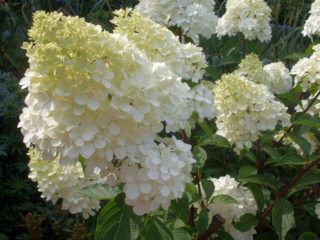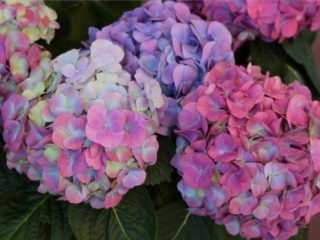Content
Treelike hydrangea is a species belonging to the genus Hydrangievye. It is a shrub up to 3 m high with white flat corymbose inflorescences. The varieties of tree hydrangea are much more modest than those of large-leaved or paniculate. But the culture is winter-hardy, even if it freezes, it quickly recovers, and blooms with the growth of the current year. This, as well as the possibility of planting on neutral and slightly alkaline soils, makes it a favorite of the owners of suburban areas and landscape designers.
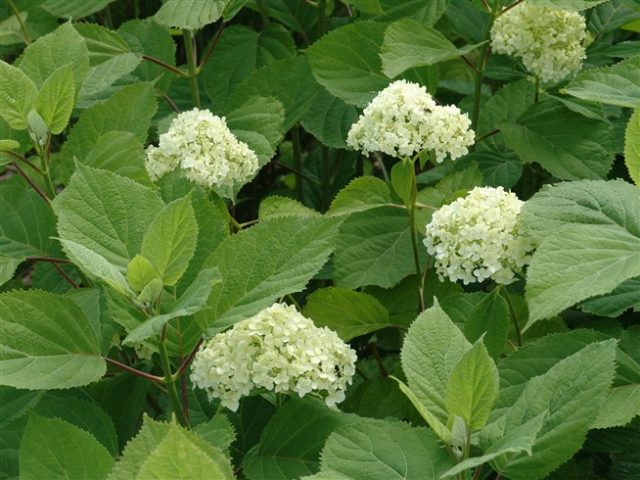
Inflorescences do not exceed 15 cm in diameter
Variety of varieties of tree hydrangea
Judging by the photos and descriptions, tree hydrangea varieties do not have such a catchy beauty as large-leaved ones, and are less popular than paniculate ones. But the flower will not go unnoticed even next to roses.
In Russia, it is the most demanded species, as it has the greatest resistance to low temperatures. Many varieties overwinter without shelter in the Middle Lane. Frozen twigs after pruning give good growth and bloom profusely.
Hydrangea tree-like lives up to 40 years. Blooms annually. Each season, the bush from July to September is wrapped in a lacy cloud of large scutes. Even in a species plant, they reach 15 cm. In varieties, flower caps are sometimes simply amazing in size.
A tree hydrangea bush can grow up to 3 m or be quite compact. In small gardens, size is easily contained by pruning. Moreover, there is no need to be afraid to remove an extra branch or shorten it more than it should be, flowering occurs on young shoots.
Often in the tree hydrangea, the color changes depending on the degree of opening of the buds. Closed petals usually have a greenish tint of varying intensity. When fully expanded, the main color appears. During wilting, pronounced salad or cream shades appear in the color.
The varieties are not yet distinguished by a rich color gamut. But pink has already joined the "native" white and lime color. Perhaps blue or lilac varieties will appear soon.
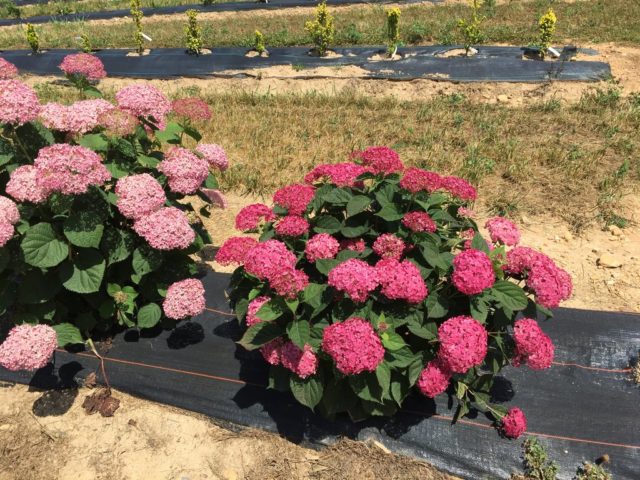
Varieties appeared with inflorescences of pink shades
The color of the buds of a tree hydrangea can be:
- white;
- lime;
- from salad to light green;
- all shades of pink.
Inflorescence-shield:
- hemispherical;
- globular;
- domed;
- in the form of an almost flat circle.
The best varieties of hydrangea tree
All varieties are beautiful and in demand. It's just that some are known more, while others are less. Treelike hydrangea is often planted in low hedges and curbs. An adult bush will be an excellent tapeworm, will fit into a landscape group or become a flower bed decoration.
Anabel
Annabelle is an old variety that still hasn't lost its popularity. On the territory of Russia and neighboring countries, it is definitely the most common. The height of the bush is about 1-1.5 m, up to 3 m wide. It grows quickly, light green leaves retain their decorative effect until frost.
Anabel's scutes are hemispherical, up to 25 cm in diameter. They consist of many white sterile flowers, loosely adhering to each other and forming a lace-like surface.Before wilting, the buds take on a greenish tint.
For thin shoots, the shields are too heavy; without support, they can bend down to the ground. Continuous bloom lasts from late June to September.
The variety is unpretentious, winter-hardy, can grow in partial shade and in the sun. Undemanding to the ground. Doesn't like transplants. In especially harsh winters, annual shoots can freeze slightly, but the bush recovers so quickly that flowering does not suffer.
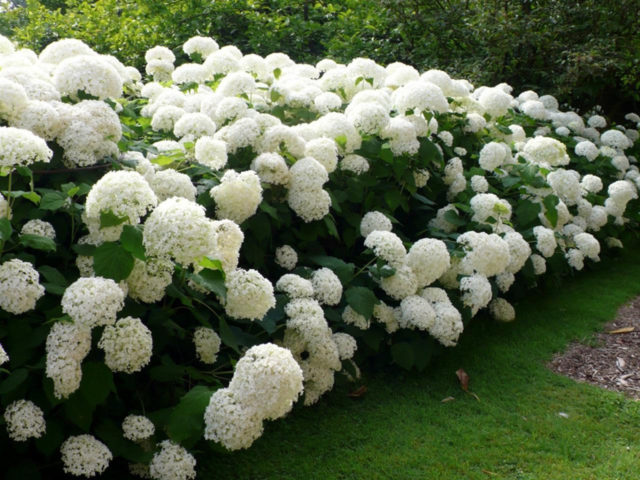
Anabel is the most famous and demanded variety.
Pink Annabelle
One of the varieties of tree hydrangea created on the basis of Anabel. The first cultivar with deep pink flowers. The scutes are large, up to 30 cm in diameter. Sterile flowers are tightly pressed against each other and collected in an irregular hemisphere.
The height of the bush is about 1.2 m, the width is up to 1.5 m. The shoots, unlike the parent variety, are strong. Under the weight of the flowers, they do not fall on the ground even in strong winds or during a rainstorm The buds open from June to September. Pink Anabel can withstand temperatures up to - 34 ° C.

Pink Anabel is the first variety with pink flowers
Hayes Starburst
Hydrangea is tree-like with double flowers, similar to stars, united in hemispherical shields up to 25 cm in diameter. The buds are first lettuce, when fully opened, they are white, after bridging they again acquire a greenish tint. Flowering - from June to frost.
The bush is 1-1.2 m high, up to 1.5 m in diameter. The shoots are thin, lodge without support, the leaves are velvety, light green. Hayes Starburst places high demands on the fertility of soils. Winter hardiness - up to - 35 ° С. In partial shade it grows well, but the inflorescences become smaller.
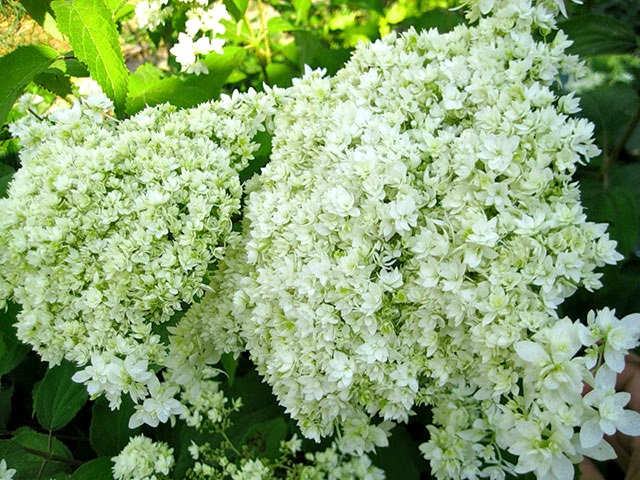
Hayes Starburst - double-flowered variety
New varieties of tree hydrangea
Older varieties boasted only white and lime colors. Now pink has been added to them, which is presented in different shades - from pale, almost transparent, to saturated. The size of the inflorescences is getting larger, and the shape is more varied.
Bella Anna
An impressive new cultivar with dark pink, almost crimson sparse semicircular inflorescences 25-35 cm in diameter. Petals with sharp tips.
Forms a bush no more than 120 cm high. Light green leaves change color to yellow in autumn. Shoots, under the weight of inflorescences, bend to the ground without support.
The variety is frost-hardy even for a tree hydrangea. Does not tolerate stagnant water in the root area. To increase the size and number of flowers of the Bella Anna hydrangea, in early spring, the shoots are shortened to 10 cm.
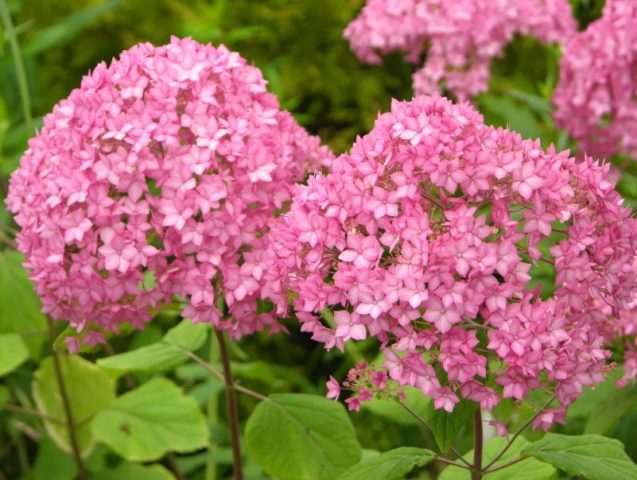
Bella Anna - a new variety with dark pink flowers
Candibelle Lolilup Bubblegum
A new variety with an original color, it is a compact shrub with a height of up to 1.3 m, a rounded crown and strong shoots. The scutes are almost spherical, irregular in shape, with densely spaced, overlapping sterile flowers, first pale pink, then white.
Can be grown in pots or containers. Numerous flowers completely cover the bush and appear from June to September. Non-capricious hydrangea with medium vigor. To make the inflorescences larger, it requires short pruning. Winter hardiness - zone 4.
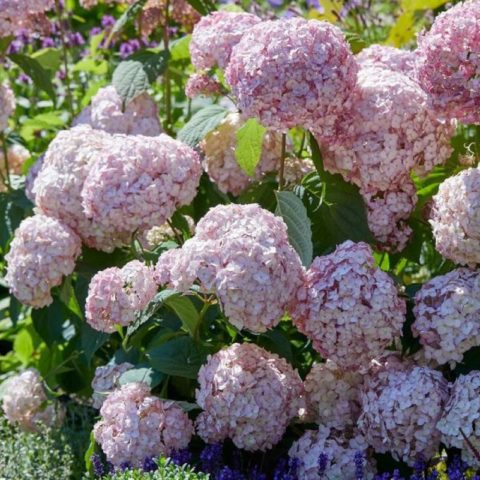
Candibelle Lolilup Bubblegum - a new variety with an original color
Candibelle Marshmello
New undersized hydrangea variety. Forms a neat rounded bush 80 cm high, with a crown diameter of up to 90 cm. The flowers are pink with a salmon tint, collected in dense hemispherical shields. The shoots are strong. Flowering - long, begins in June, ends by the end of September. Winter hardiness - zone 4.

Candibella Marshmello has salmon pink flowers
Golden Annabel
Another improvement of the old famous variety. The bush grows to a height of 1.3 m and forms a rounded crown. Inflorescences are white, very large openwork, up to 25 cm in diameter.At Golden Annabelle, the leaves are decorated along the edge with a wide salad border. Frost resistance - up to - 35 ° С.
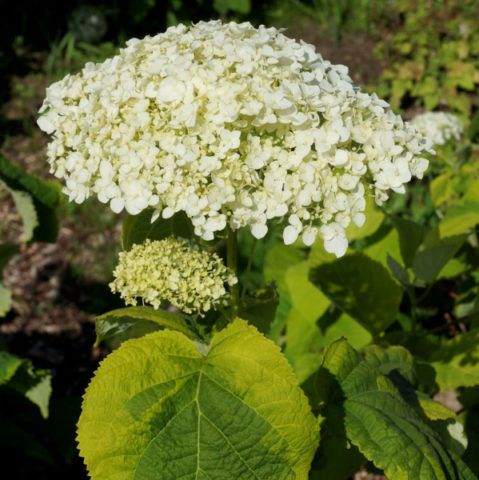
Hydrangea Golden Annabel has original leaves with a golden-green border
Incredibol Blush
New large variety, very hardy (zone 3). A bush with strong branches grows up to 1.5 m. The dark green leaves are heart-shaped, do not change color until falling off. Inflorescences are large, hemispherical. When blooming, the buds are pale pink with a silvery tinge, from a distance they seem light violet. Over time, the petals darken.
Hydrangea Incrediball Blush is undemanding to lighting. For abundant regular flowering, the formation of especially large scutes, a short pruning is needed before the start of sap flow. Long standing in bouquets. Used as a dried flower.
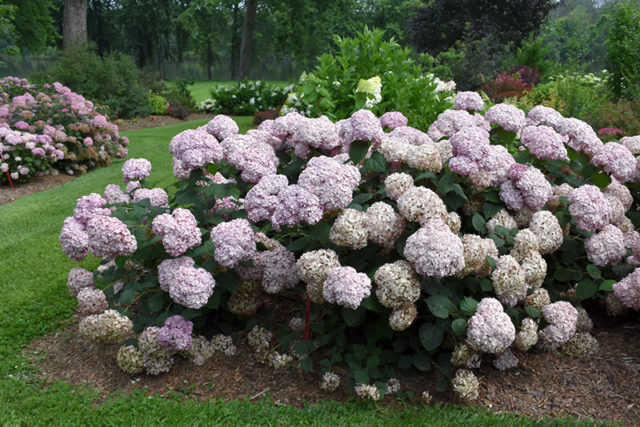
From a distance, it seems that the flowers of the hydrangea Incredibol Blush have a lilac hue.
Winter-hardy varieties of hydrangea tree
This is the most frost-resistant type of hydrangea. In zone V all varieties overwinter without shelter. Most freeze in IV only at minimal temperatures and quickly recover. Even in zone III, many varieties of tree hydrangea can be planted under a shelter. Probably, there they will not even become a one and a half meter tree, but they will bloom.
Bounty
Variety Bounty forms into a strong shrub up to 1 m high. Shoots do not lodge even after rain. Blooms from June to late October. Lace shields, hemispherical. The flowers are lettuce before blooming, then white.
Grows in partial shade and in a well-lit place if the bush is protected from direct sunlight at noon. This hydrangea is not picky about the composition of the soil, but requires abundant, frequent watering. Hibernates in zone 3.

Bounty hydrangea buds that have begun to open
Strong Anabel
Another hydrangea obtained from the old Anabel variety. More frost-resistant. Lacy, almost round shields are simply huge - about 30 cm in diameter. Large sterile flowers are greenish at first, then white.
It is a bush 1.5 m high, 1.3 m in diameter. Shoots are erect, strong, with large oval leaves up to 15 cm long, which change color to yellow in autumn. Bloom - from July to September.
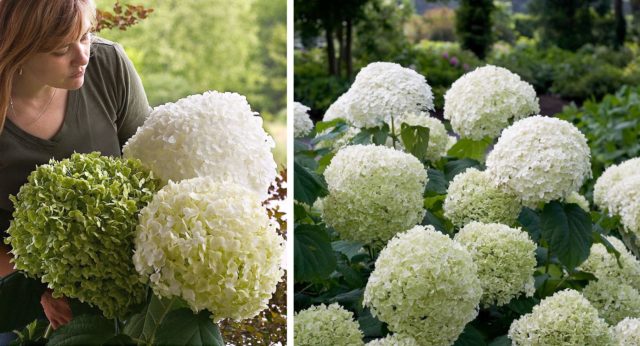
Inflorescences of Hydrangea Strong Anabel are very large
White Dome
White Dome is distinguished by dark green leaves and flat shields, in which large, white, sterile flowers are located only at the edges. In the center are creamy or salad fertile.
The hydrangea got its name because of the dome-shaped crown. Shoots are strong, thick, do not need support. Bush 80-120 cm high.It hibernates in zone 3.

In the White Dome variety, large sterile flowers only frame the shield
Varieties for the Moscow region
Actually, near Moscow, you can plant any of the varieties of tree hydrangea. They all winter well there. Even if the bush freezes under a strong drop in temperature or due to icing, it will quickly recover in the spring and bloom in the same summer.
Grandiflora
The spectacular Grandiflora grows very quickly, even for the Tree Hydrangea. Forms a bush up to 2 m high, with a diameter of about 3 m. Convex shields 20 cm in size are first lettuce, then snow-white, at the end of flowering they acquire a cream shade.
The variety is winter-hardy, grows better in good lighting. Drought intolerant. He has lived in one place for 40 years. Doesn't like transplants.

Hydrangea Grandiflora has dome-shaped inflorescences of irregular shape
Lime Ricky
A very winter-hardy variety, suitable for planting in climatic zone 3. In the Moscow region, it rarely freezes. Shoots are cut short so that the flowering is abundant, and the shields are formed large.
It forms a neat bush with a height of 90 to 120 cm. The branches are strong, thick, withstand bad weather well. The scutes are convex, dome-shaped, dense, composed of sterile flowers with obovate petals. The color is lime at first, gradually brightens. Bloom - July-September.
The variety grows well on any soil, undemanding to lighting. The shields are often cut and used as dried flowers.
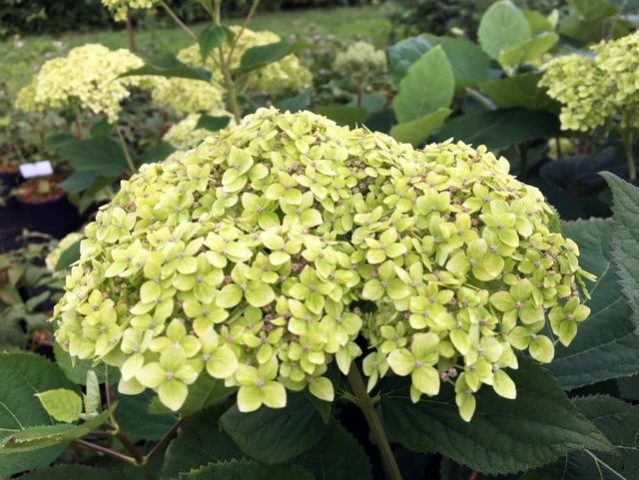
Hydrangea Lime Peaks grows well in the suburbs
Sterilis
Fast-growing hydrangea with a height of 1.5-1.8 m with a crown diameter of up to 2.3 m. Not as frost-resistant as many varieties, but in the Moscow region it winters without shelter. Blooms from July to September.
Shields are domed, about 20 cm in diameter. Flowers are white, greenish before blooming. The variety prefers acidic soils, undemanding to lighting.
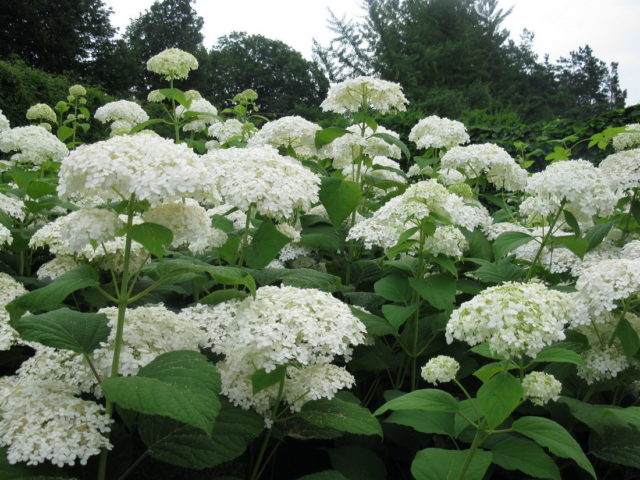
Hydrangea treelike Sterilis rather high
Conclusion
The varieties of Tree Hydrangea are not as diverse as in other species, but they form large openwork flower caps and can serve as a decoration for any garden. To the advantages of the culture should be added frost resistance, undemanding care, the ability to grow on neutral and alkaline soils. Cut branches produce excellent dried flowers.


